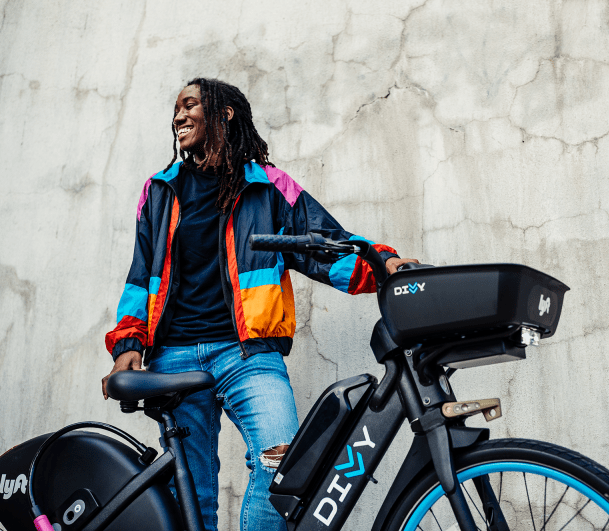The number of Americans using a bike for transportation and/or recreation has increased during COVID-19 as more people look for socially-distant ways to commute or exercise. Early on in the pandemic the Chicago Department of Transportation offered a number of bike-share discounts, such as free Divvy rides for healthcare workers, plus discounted single rides and memberships for the general public, as a pandemic response. Chicago’s bike-share system saw a record number of rides last summer with the introduction of electric pedal-assist Divvies. I’ve been curious about the demographics of riders during the COVID-19 pandemic. While the exact demographics of Divvy users are not available, researchers Max Jordan Nguemeni Taiko and Daniel C. Stokes looked at bike-share companies COVID responses and disparities in bike-share access.
COVID-19 disproportionately impacted communities of color due to systemic inequities. One reason for the disproportionate impact is the large number of Black and Latinx people working essential jobs, such as retail, food service, public transportation, and healthcare, rather than being able to social distance while working remotely.
Researchers Taiko and Stokes first looked at bike-share companies' COVID-19 response. Many systems offered free or low-cost memberships to essential workers. While some companies like Divvy focused on offering free rides on healthcare workers, others were inclusive of food service and food retail workers. New York City’s Citi Bike system offered a 30-day membership and unlimited 45-minute trips to transit workers, emergency responders, and healthcare workers. Washington DC’s Capital Bikeshare system was inclusive of food service and food retail employees.
Philadelphia's Idego sytem offered a discounted one-month membership, lower daily fees, and special pricing for low-income riders. Those who work for restaurants, grocery stores, and the hospitality industry were left out of the Chicago, NYC, Boston, and San Francisco’ bike-share essential worker discounts.
I really liked this line in the study, “Such arbitrary delineation unwittingly devalue some, and prop up other classes of workers, and in this case, potentially contributes to the problematic healthcare hero narrative, leaving unacknowledged the critical role food and service workers have played in sustaining life during the pandemic.” It really begs the question of just who is an essential worker in the eyes of the larger public and in the eyes of bike-share companies.
Taiko and Stokes found that while bike share companies' efforts helped residents avoid risking COVID exposure on transit (although studies have found riding transit during the pandemic has been fairly safe), the reach of these efforts was limited by the types of worers who were given free memberships.
They also noted that equity has been an issue with bike-share before the pandemic. In NYC, most Citi Bike docking stations are in Manhattan and Brooklyn, while Queens and the Bronx are home to a larger share of Black, Latinx and low-income residents and higher rates of COVID infections and deaths. Nationwide, bike-share networks are concentrated in urban neighborhoods with a high density of people, transit stations, and retail destinations, where residents are more likely to be white, relatively affluent, and proficient in English, based on a national survey.
Additionally, bike-share networks disproportionately serve higher-earning, college-educated, white-collar workers in nearly every city. In a survey-based study by the Better Bike Share Partnership, results showed only 2 percent of lower-income residents in Philadelphia, Chicago, and Brooklyn were bike-share members, compared to 5 percent of higher-income people of color and 10 percent of higher-income white residents. So, while bike share companies have had good intentions during COVID, due to limited eligibility for pandemic-related discounted memberships and the inequitable distribution of stations, those most in need of alternatives to public transportation were not reached by these efforts.
Taiko and Stokes recommend bike-share companies reach out to residents, community organizations, and local leaders in neighborhoods of color to discuss ways to remedy this situation. Solutions for improving bike-share access among people of color and low-income folks are to understand the barriers to bike-share use, address those barriers, and broadcast what's going to be done differently in the future so that people can take advantage of the new opportunities. Researchers also recommended two approaches to achieving equity: voluntary or state-mandated. Given the low level of interest in bike-share at the state level in most parts of the country, it seems unlikely that state legislators would pass laws mandating equitable station distribution or targeted marketing campaigns for folks of color and/or low-income communities.
A study of bike-share users in Better Bike Share Partnership areas, locations traditionally underserved by bike-share, found that people who used bike-share less often were less likely to be exposed to bike-share through friends and family and were more dependent on community outreach campaigns. Taiko and Stokes recommended possible solutions such as cash payment without registration, registration via dock-based kiosks, registration through employers, and integration with transit fare cards, plus collaboration with city planners, community biking advocates, and bike-share companies to gauge interest in these solutions and disseminate information about them.
Taiko and Stokes say they realize that equitable distribution of bike-share will not benefit everyone equally. Traffic safety and personal safety issues, plus land-use patterns that create long distances between residents and workplaces, retail, and other destinations can be deterrents. Despite the fact that neighborhoods of color are more likely to have to road layouts that prioritize vehicles over people, there has been a 90-percent increase in bike riding among Black people according to a People For Bikes analysis of National Household Travel Survey data. More focused equity work would likely increase the number of people of color using bike-share.




